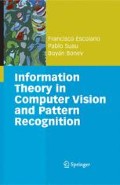Abstract
One of the most complex tasks in computer vision is segmentation. Segmentation can be roughly defined as optimally segregating the foreground from the background, or by finding the optimal partition of the image into its constituent parts. Here optimal segregation means that pixels (or blocks in the case of textures) in the foreground region share common statistics. These statistics should be significantly different from those corresponding to the background. In this context, active polygons models provide a discriminative mechanism for the segregation task. We will show that Jensen–Shannon (JS) divergence can efficiently drive such mechanism. Also, the maximum entropy (ME) principle is involved in the estimation of the intensity distribution of the foreground.
It is desirable that the segmentation process achieves good results (compared to the ones obtained by humans) without any supervision. However, such unsupervision only works in limited settings. For instance, in medical image segmentation, it is possible to find the contour that separates a given organ in which the physician is interested. This can be done with a low degree of supervision if one exploits the IT principle of minimum description length (MDL). It is then possible to find the best contour, both in terms of organ fitting and minimal contour complexity. IT inspires methods for finding the best contour both in terms of segregation and minimal complexity (the minimum description length principle).
Access this chapter
Tax calculation will be finalised at checkout
Purchases are for personal use only
Preview
Unable to display preview. Download preview PDF.
Key References
M. Figueiredo, J. Leita~o, and A.K. Jain. “Unsupervised Contour Representation and Estimation Using B-splines and a Minimum Description Length Criterion”. IEEE Transactions on Image Processing 9(6): 1075–1087 (2000)
G. Unal, A. Yezzi, and H. Krim. “Information-Theoretic Active Polygons for Unsupervised Texture Segmentation”. International Journal of Computer Vision 62(3):199–220 (2005)
G. Unal, H. Krim, and A. Yezzi. “Fast Incorporation of Optical Flow into Active Polygons”. IEEE Transactions on Image Processing 14(6): 745–759 (2005)
B. Jedynak, H. Zheng, and M. Daoudi. “Skin Detection Using Pairwise Models”. Image and Vision Computing 23(13): 1122–1130 (2005)
Z.W. Tu and S.C. Zhu. “Image Segmentation by Data-Driven Markov Chain Monte Carlo”. IEEE Transactions on Pattern Analysis and Machine Intelligence 24(5): 657–673 (2002)
Z.W. Tu, X.R. Chen, A.L. Yuille, and S.C. Zhu. “Image parsing: Unifying Segmentation, Detection and Recognition”. International Journal of Computer Vision 63(2):113–140 (2005)
S.C. Zhu and A.L. Yuille. “Region Competition: Unifying Snakes, Region Growing, and Bayes/MDL for Multiband Image Segmentation”. IEEE Transactions on Pattern Analysis and Machine Intelligence, 18(9): 884–900, (1996)
S. Geman and D. Geman. “Stochastic Relaxation, Gibbs Distributions, and the Bayesian Restoration of Images”. IEEE Transactions on Pattern Analysis and Machine Intelligence, 6 (pp. 721–741), (1984).
X. Chen and A.L. Yuille. “Time-Efficient Cascade for Real Time Object Detection”. First International Workshop on Computer Vision Applications for the Visually Impaired. Proceedings of IEEE Conference on Computer Vision and Pattern Recognition, San Diego, CA (2004)
G. Winkler. Image Analysis, Random Fields and Markov Chain Monte Carlo Methods: A Mathematical Introduction. Springer, New York (2003)
Rights and permissions
Copyright information
© 2009 Springer Verlag London Limited
About this chapter
Cite this chapter
(2009). Contour and Region-Based Image Segmentation. In: Information Theory in Computer Vision and Pattern Recognition. Springer, London. https://doi.org/10.1007/978-1-84882-297-9_3
Download citation
DOI: https://doi.org/10.1007/978-1-84882-297-9_3
Publisher Name: Springer, London
Print ISBN: 978-1-84882-296-2
Online ISBN: 978-1-84882-297-9
eBook Packages: Computer ScienceComputer Science (R0)

